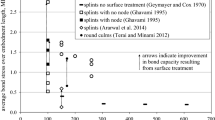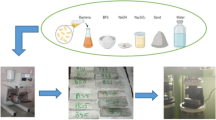Abstract
Lime mortars are often used for repairs to historic buildings. This paper investigates two forms of lime binder: fat and feebly-hydraulic, in order to predict their long-term behaviours and hence ascertain which of the two possesses greater durability, so that they may be used more efficiently in restoration. Mortars were tested for properties governing moisture movement and also subject to durability cycles. The resistance to damage under freezing conditions was evaluated with the saturation coefficient. Thermal cycles had no effect on the mortars and gave no indication of the relative durabilities of the binders. Salt crystallization cycles, though effective in distinguishing the more durable of the two, were too aggressive to gauge a clear profile of salt weathering and succeeded in rapidly decomposing the samples. Tests on the properties governing moisture movement produced good indications of the degree to which the mortars permit flow through their fabrics. According to the results obtained, fat lime mortars are more durable than those made with feebly-hydraulic lime. The results also suggest that the feebly-hydraulic lime mortars are at a higher risk of decomposition by granular disintegration whereas fat lime mortars are better suited to damp, slightly exposed conditions. These results disagree with the general opinion that hydraulic limes are more durable than fat limes due to the additional strength and water insolubility arising from their hydraulicity.
Similar content being viewed by others
References
Holmes S, Wingate M (1997) Building with lime: A practical introduction, 2nd Edn. ITDG, London.
Pavía S, Bolton J (2000) Stone, brick and mortar. Wordwell, Bray.
Vicat LJ (1997) A practical and scientific treatise on calcareous mortars and cements. John Weale, London, 1837, reprinted byDonhead.
Cowper AD (1998) Special Report No. 9, lime and lime mortars. Department of Scientific and Industrial Research, His Majesty's Stationery Office, London, 1927, reprinted by Donhead.
Ashurst J, Ashurst N (1988) Practical building conservation, Volume 3: Mortars, plasters and renders. Gower Technical Press, Aldershot.
Gibbons P (1995) Historic scotland technical advice Note no. 1 Preparation and use of Lime Mortars. Historic Scotland, Edinburgh.
The Traditional Lime Company (2000) A guide to lime and it's uses in conservation and restoration of buildings. The Traditional Lime Company, Carlow.
BS EN 1015-1 (1999) Methods of test for mortar for masonry. Determination of particle size distribution (by sieve analysis).
BS EN 459-2, 3 (2001) Building lime. Test methods. Conformity evaluation.
Commission 25-PEM, RILEM (1980) Essais recommandés pour mesurer l'alteration des pierres et évaluer l'efficacité des méthodes de traitement. Materiaux et Constructions, Bull. Rilem 13(75):216–220.
Pavía S, Bolton J (1997) Laboratory studies of the interaction between bedding/pointing mortar and building stones. International Journal for Restoration of Buildings and Monuments 3(3):253–268.
BS 1881: Part 122:1983. Testing concrete. Methods for determination of water absorption.
BS EN 1925:1999 Natural stone test methods. Determination of Water Absorption Coefficient by Capillarity.
Caro Calatayud S (1994) Piedra, ladrillo y mortero: Caracteristicas y alteracion. Alfaro, Calahorra y Logroño', Gobierno de La Rioja, IER, Logroño.
Pavía Santamaría S (1994) Material de construcción antiguo de Logroño y La Rioja Alta: petrografía, propiedades físicas geología y alteración. Gobierno de La Rioja, IER, Logroño.
Latta JK (1964) L'eau et des materiaux de construction. Digest de la Construction au Canada 30:4–11.
Author information
Authors and Affiliations
Rights and permissions
About this article
Cite this article
Pavía, S., Treacy, E. A comparative study of the durability and behaviour of fat lime and feebly-hydraulic lime mortars. Mater Struct 39, 391–398 (2006). https://doi.org/10.1617/s11527-005-9033-4
Received:
Accepted:
Published:
Issue Date:
DOI: https://doi.org/10.1617/s11527-005-9033-4




